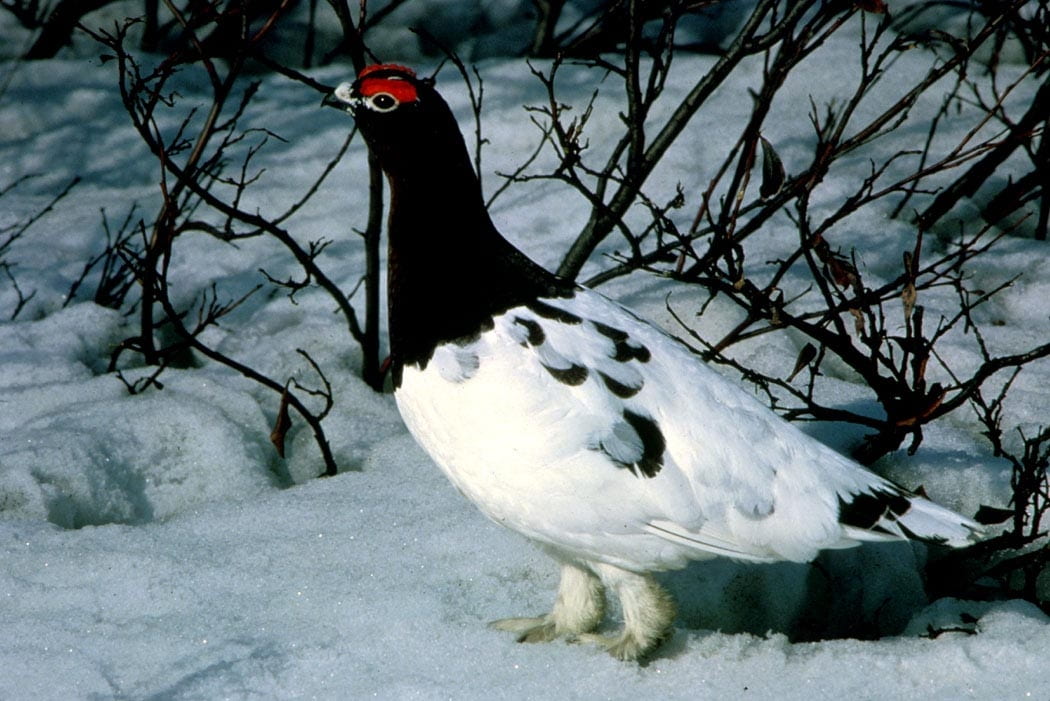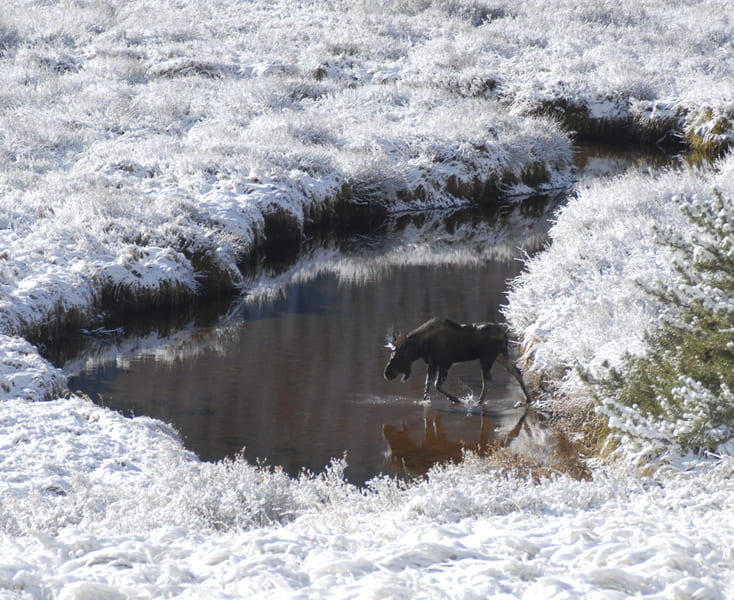“A Young Man Carries About Fire All Winter”
Culture: Dunne-za | Narrator: Ike of Vermilion | Source: Goddard (1916:266)
Entry by Asher Loewenstern & Michelle Scalise Sugiyama
Story
There was a young man who went around alone one winter. He had neglected to provide himself with the proper stones for making fire before the snow came and covered them up. He was therefore obliged to carry fire with him wherever he went. He was without food and starving one night when he killed a partridge. He scraped away the snow, built a fire, and cooked the partridge. He ate the bird and when he had finished dropped the feet in the snow behind him.
The next day he went on and wandered about for many days without being able to kill anything. Finally, he came back to the same place and cleared away the snow for a fire. As the fire melted the snow away he saw the discarded partridge feet. He then recognized his former camping place. He picked up the feet and ate them. That night a partridge came to him in his sleep and said, “You were proud. You were too proud to eat my feet as other people do, but now you want to have them. You are miserable and about to die, but from now on you will be all right. By tomorrow night you will have plenty to eat.” The next day he went about thinking all day long he would find some game as had been promised. Night came without his having had a chance to kill anything. He moved the snow away and built his fire against a drift that the heat might be reflected toward him. He sat there wondering that an animal should deceive him by making a promise that had not been fulfilled. As the fire grew hot he heard a sound like the frying of grease. He kept pushing the fire together and as he did so the sound was heard again. He finally noticed the drift of snow covered a moose which had been killed in the fall when it was fat. The fire had been built near the hips of the moose and the choicest parts were ready cooked. He had the whole moose to himself and was all right after that.
Traditional Ecological Knowledge
Zoology
This story warns that game animals can be scarce in winter. This is seen in the observation that the young man “wandered about for many days without being able to kill anything.” The story then provides information about how to cope with this problem: when the man kills a partridge, this identifies a species that does not hibernate or migrate and is thus a potential source of food at this time of year. The story also notes that the feet of this bird are edible. This information is useful because it identifies an additional source of energy at a time when every calorie counts.
The story identifies another means of acquiring food in winter: scavenging. This is seen when the man discovers the moose carcass buried in a snowdrift. The latter information indicates that meat that has been frozen soon after it was killed is safe to eat. The observation that the moose was killed in the fall “when it was fat” indicates that moose are at their fattest in the fall and that moose hunting thus provides the biggest nutritional payoff in autumn. The story also indicates that the “choicest parts” of a moose are the hips.
Photo by Michelle Scalise Sugiyama
Physical Geography
This story provides information about climate. The fact that the moose carcass is completely hidden by snow indicates not only that winters are snowy, but that snowfall is heavy. The scarcity of game indicates that the cold is severe, driving animals to seek shelter in their dens.
Cultural Geography
By stressing the importance of preparing for winter, this story identifies cultural values that are critical to survival. First, the story chides the young man for his laziness and lack of foresight. This is seen in the observation that he had “neglected” to provide himself with stones for making fire and that, as a result, he is “obliged” to carry burning coals with him wherever he goes. The story implies that this contributes to his poor hunting luck, because fire-tending is incompatible with tracking and stalking game. The story further implies that it is foolhardy to travel alone in winter, because it is difficult for one person to perform all of the tasks necessary for survival. This point is underscored by the fact that the man is “miserable and about to die” of starvation, and has no one to help him. The story also discourages wastefulness. This is seen when the partridge scolds the young man for being “too proud” to eat its feet. This point is reiterated when the man finds the moose carcass and eats it without hesitation, apparently having learned his lesson.
Technology
This story provides valuable information about fire making by noting that the young man neglected to provide himself with the proper stones for making fire before the snow covered them up. This indicates that, in order to make fire using the percussion method, a certain type of stone is needed, and that these stones cannot be found once snow has fallen. The story thus warns people to gather some of these stones before winter comes; otherwise they will have to keep their fire lit and carry it with them all winter long. The story also provides information about fire building, noting three times that the man clears away the snow before making a fire, and that he builds it against a snow drift. This may serve to reflect the heat, thereby increasing the amount of warmth directed at the body. This, in turn, may reduce the energetic costs of thermoregulation and the chances of freezing to death. The man’s discovery of the moose carcass alludes to a means of preserving meat: in cold climates, meat can be frozen by burying it in snow, and then retrieved as needed.
The Land and The People
The traditional homeland of the Beaver people includes the Peace and Halfway River drainages, and the headwaters of the Liard River. This area of 75,000 square miles consists largely of boreal forest and aspen parkland, and stretches from the eastern base of the Canadian Rockies in what is now British Columbia, to the falls about forty miles below Vermilion, in what is now Alberta. Neighboring groups included the Chipewyan to the east, the Slavey to the north, and the Sekani to the west.
The Canadian Subarctic is characterized by long, cold winters and short summers. Most precipitation falls as snow; accumulation is heavy in boreal and transitional forests, and snow cover lasts an average of six months. In addition to duration, snow density, hardness, and depth have significant effects on animal behavior, flora, human activities, and lake, river, and ground ice. Although the mean maximum snow depth is 20 to 30 inches, drifts that form in the lee of trees and ridges are much deeper.
Like many of their neighbors, the Beaver people speak an Athabaskan language. Their autonym, Dunne-za, means “our people” and signifies people with whom one has a kinship connection. The name “Beaver” may derive from the Peace River, which was called the “Beaver River” by their Chipewyan neighbors. This name may reference the abundance of beaver in the region and their importance as a food resource.
Photo by sempre dilunedi on Unsplash
Rock ptarmigan (Lagopus muta) | Photo by Jan Frode Haugseth
The “partridge” in the story is probably a ptarmigan: both are Phasianidae, but only ptarmigan are native to North America. Several ptarmigan and grouse species were consumed by Indigenous peoples of the Canadian Subarctic, including the willow ptarmigan (Lagopus lagopus) and the rock ptarmigan (L. muta), both of which are found in northern British Columbia and Alberta.
The Dunne-za depended heavily on moose for food, which was the largest and most widely distributed game animal in their territory. Survival in this climate required at least two pounds of meat per person per day. For a band of 30, this amounted to one moose every week. Even a short period of illness, inclement weather, game shortages, or bad hunting luck could bring the entire band to the brink of starvation. To mitigate this problem, meat was stored in caches for use in time of need.
Photo by Phil Myers
Painting by Karl Bodmer
Moose were also an important source of raw materials. Their hide provided tipi covers, parkas, and moccasins, their horn was fashioned into arrowheads and knives, and their leg bones were used as fleshers. Fire was made by striking stones of iron pyrite or flint together. For temporary shelters, windbreaks were built out of brush in order to “reflect back the heat of the fire” (Goddard 1916:212).
The Dunne-za placed great value on knowledge and those who “know something” (Ridington 1982:473), which they considered more important than material possessions. Storytelling was an important means of transmitting knowledge about proper relations with the land, animals, and people. The Dunne-za believed that animals distanced themselves from humans when the latter behaved badly. This is illustrated in the story by the young man’s struggle to find food. This is his own fault: in striking out on his own without making adequate preparations for winter, he has been arrogant, irresponsible, and lazy. This is underscored when the partridge chides him for being too proud: he still has much to learn.
“Besides providing entertainment the stories were the medium through which a philosophy combining self-reliance and interdependence was taught.”
—Ridington (1981:355)
Map
The traditional homeland of the Dunne-za people includes the Peace and Halfway River drainages, and the headwaters of the Liard River in what are now British Columbia and Alberta, Canada.
References
Gardner, J. (1981). General environment. In J. Helm (Ed.), Handbook of North American Indians, Vol. 6: Subarctic. Washington, D. C.: Smithsonian Institution, 5-14.
Gillespie, B. (1981). Major fauna in the traditional economy. In J. Helm (Ed.), Handbook of North American Indians, Vol. 6: Subarctic. Washington, D. C.: Smithsonian Institution, 15-18.
Goddard, P. (1916). The Beaver Indians. Anthropological Papers of the American Museum of Natural History, Vol. 10, Part 4. New York: Trustees.
Hejna, M. (2002). “Lagopus muta” (On-line), Animal Diversity Web. Accessed January 28, 2021 at https://animaldiversity.org/accounts/Lagopus_muta/.
Morland, S. (2011). “Lagopus lagopus” (On-line), Animal Diversity Web. Accessed January 28, 2021 at https://animaldiversity.org/accounts/Lagopus_lagopus/.
Ridington, R. (1981). Beaver. In J. Helm (Ed.), Handbook of North American Indians, Vol. 6: Subarctic. Washington, D. C.: Smithsonian Institution, 350-360.
Ridington, R. (1982). Technology, world view, and adaptive strategy in a northern hunting society. Canadian Review of Sociology and Anthropology, 19(4), 469-481.














